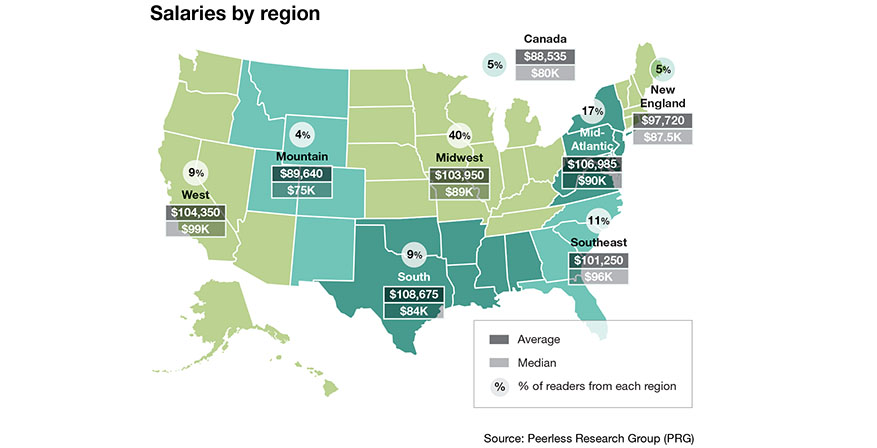Opportunity knocks: 12th-annual materials handling professionals salary survey
Materials handling professionals continue to enjoy the industry’s exciting pace of innovation and are hungry to tackle the challenge.
or the first time in its 12-year history, Modern’s annual salary survey of our readers shows signs of restlessness among materials handling professionals. Many of the usual satisfaction metrics remain as strong as ever, and compensation continues to track upward in line with company performance. Ninety-two percent of industry professionals said they would recommend the career to others. But one number stood out as the lowest ever for our survey. The answer to the simple question: “Do you like your current job?” has fallen 7% to 85%.
Similarly, the number of respondents passively looking for another job has nearly doubled to 28%, and one in 10 report they are actively looking for a way out, up from 5% last year.
Based on survey results, it’s possible the same factors that reinforce satisfaction might also contribute to the desire to find greener grass, technology, innovation and opportunities for challenges.
Job satisfaction
Satisfaction remains strong, with 50% of respondents saying they were very satisfied and 20% reporting they were extremely satisfied with their jobs. More than a quarter of professionals said they are somewhat satisfied with their careers, 3% are not very satisfied and 0% are not at all satisfied.
Last year, 41% of respondents indicated no interest in seeking another job, tying the record-high set in 2012. Now, 35% said they are happy where they are. Down from 39% last year, 27% said they are “always open to other possibilities.” And, 38% of respondents are now passively or actively looking for work elsewhere, up from 20% last year. Those looking to move are motivated primarily by compensation (53%), the desire for new challenges (37%) and a lack of advancement opportunities (33%).
Levels of stress seem to have little to do with satisfaction. Last year, nearly half reported their jobs are very (38%) or extremely (9%) stressful. These figures now stand at 29% and 10% respectively, while 48% say work is somewhat stressful, 10% not very and 3% not at all. Respondents are asked to compare current stress levels to those of two years ago, and the results have changed little in the last four surveys. In 2019, respondents reported more stress (44%), less stress (16%) and the same (40%).
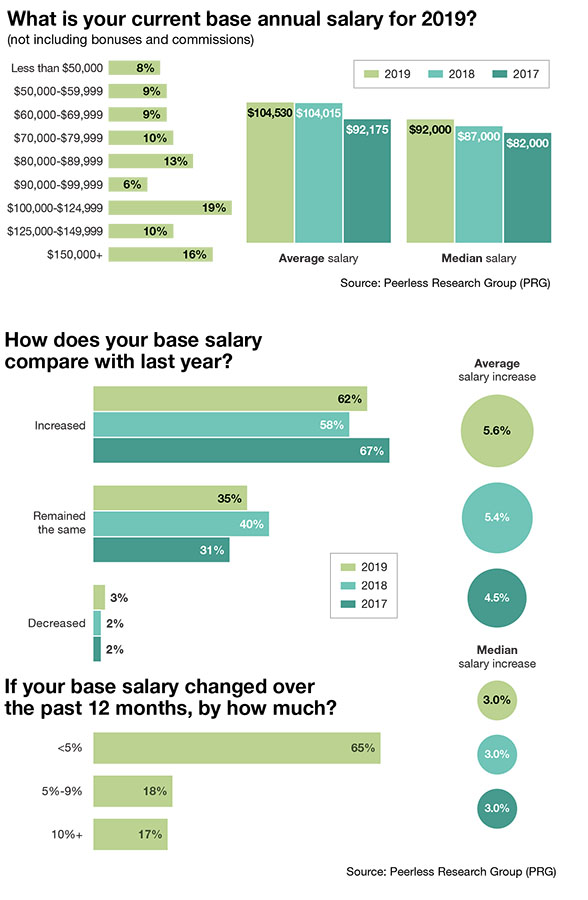 Those in extremely, very or somewhat stressful positions earn an average of about $108,000, up slightly from last year, and up 20% from 2017’s average of $90,000. The 13% of those who claim work is not stressful will bring home an average of about $112,000, a number that has swung by double digits in one direction or the other in recent years.
Those in extremely, very or somewhat stressful positions earn an average of about $108,000, up slightly from last year, and up 20% from 2017’s average of $90,000. The 13% of those who claim work is not stressful will bring home an average of about $112,000, a number that has swung by double digits in one direction or the other in recent years.
The top factors contributing to stress include workload (46%), lack of people (43%), not having enough time (39%), and balancing work and home life (38%).
After consecutive years of decline, the frequency of dramatic cost-saving measures saw a slight uptick this year, with 25% reporting reduced overtime and 23% enacting a hiring freeze. Layoffs held steady at 19%, while reduced benefits has fallen to 18%. In 2019, 7% of respondents were personally affected by layoffs, level with 2018.
As reported by respondents, the average turnover rate within their own departments continues to creep upward, from 8.2% in 2017 to 10.2%. Five years ago, the figure hovered between 6% and 7%, and one third (33%) of respondents reported zero turnover. This year only 23% reported no turnover.
Readers point out industry pros and cons
For all the innovation and upheaval in the industry, appreciation remains abundant for the job’s challenging and rewarding nature.
Why would you recommend the materials handling profession to others? (92%)
- To me, in my profession, every day feels like the first day of work. I am always excited to see what the day will bring.
- There are only so many ways to make a product. Delivering it to the end consumer? The options are endless.
- It has been a solid profession for 35 years. It has steady growth and is something that is always needed within manufacturing and the supply chain.
- This industry allows professionals to directly impact the everyday lives of every person in the country. I like the satisfaction of seeing the difference our systems make for our clients in tangible and immediate ways.
- The material handling business is cutting-edge in our economy. We touch everything that is sold and new technologies are driven though this industry. We are a competitive advantage to customers who use us.
- The career fell into my lap. It’s not a degree I pursued in college although now I wish I had. It’s been a long and winding road, but I’ve learned a lot and have been challenged through the years. I’ve put in a lot of long days and hard work but the results have been great. I’ve met a lot of great people, most of whom I consider friends. The logistics community is a relatively small one and you run into the same people over and over in your career.
Why would you not recommend the materials handling profession to others? (8%)
- Lack of respect from C level for logistics.
- Engineers are generally treated as a commodity—i.e., “anyone can follow the steps in a book.”
- This is not the most stable of environments.
- There is too much competition and you have to depend on others to get the job done and not everybody in the chain is doing their job.
The compensation picture
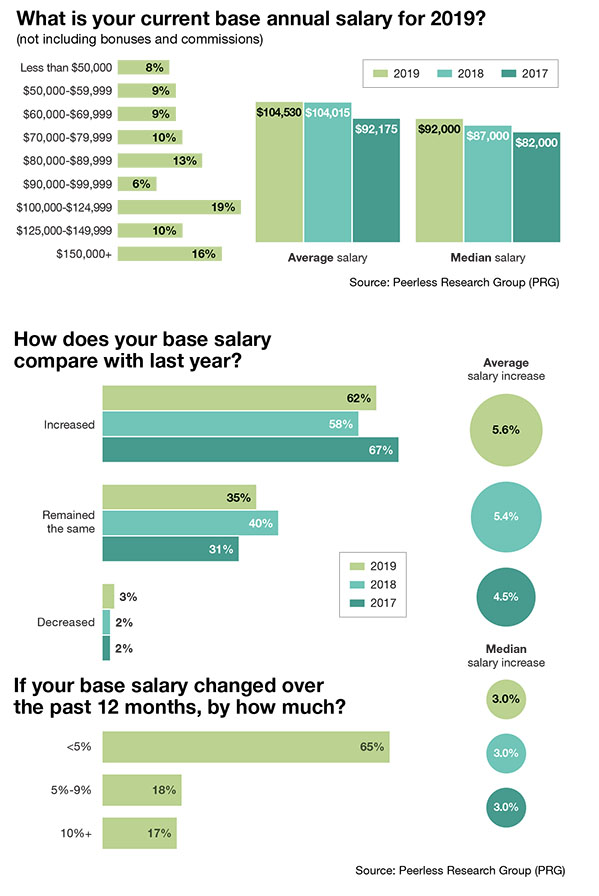 Average base salaries had dipped by several thousand before breaking into six digits at $104,015 in 2018. This year, the average stayed about level. Of the 62% of respondents who said their salary had increased in the previous 12 months, two-thirds saw increases of less than 5%, about one in five reported salaries increased between 5% and 9%, and 17% saw paychecks go up by 10% or more. The average base salary increase was 5.6%. And, 3% reported their salaries had decreased.
Average base salaries had dipped by several thousand before breaking into six digits at $104,015 in 2018. This year, the average stayed about level. Of the 62% of respondents who said their salary had increased in the previous 12 months, two-thirds saw increases of less than 5%, about one in five reported salaries increased between 5% and 9%, and 17% saw paychecks go up by 10% or more. The average base salary increase was 5.6%. And, 3% reported their salaries had decreased.
In 2019, three quarters of respondents expect to receive a bonus averaging $20,820. This is down from four years of hovering around $25,000. However, the median is up to $12,000, reflecting more small and medium bonuses.
More than two-thirds of bonuses are granted based on the company reaching its performance goals, a percentage that had trended slightly downward in recent years before spiking to 2014 levels. Previously on a multi-year upward trend, bonuses granted for lowering operational costs dipped to 23% in 2018 before jumping up five points.
Earnings by experience, demographics
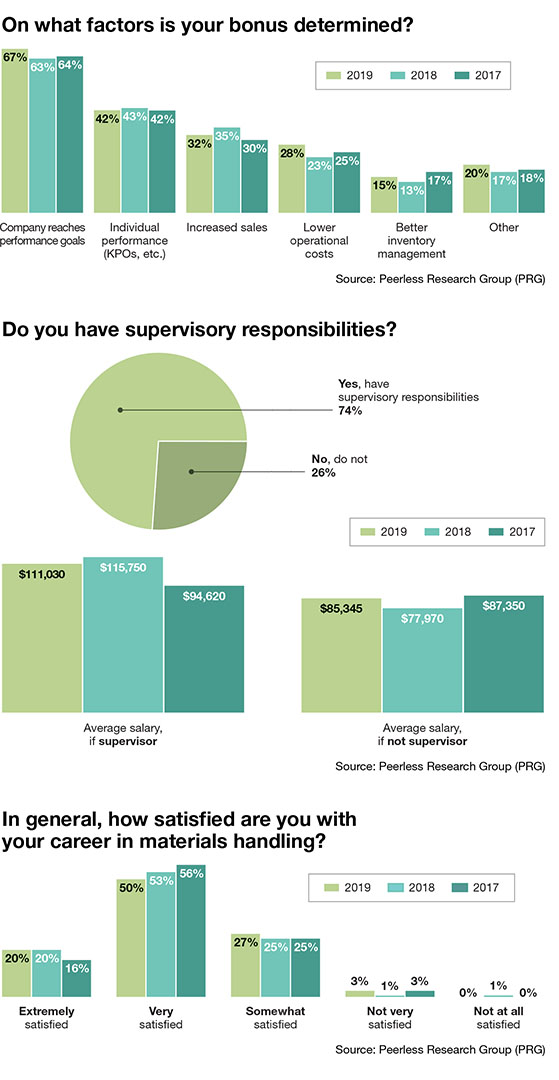 On average, those who have been in the industry less than five years (11%) can expect to earn $78,305. This is down a few thousand dollars, but at $75,000, the median earnings for newcomers continue to trend sharply upward from $55,000 in 2016. Those who stick with it for between 10 and 20 years (23%) will be knocking on the door of six figures. Above the 30-year mark (24%), the average salary is $119,000, down nearly $10,000.
On average, those who have been in the industry less than five years (11%) can expect to earn $78,305. This is down a few thousand dollars, but at $75,000, the median earnings for newcomers continue to trend sharply upward from $55,000 in 2016. Those who stick with it for between 10 and 20 years (23%) will be knocking on the door of six figures. Above the 30-year mark (24%), the average salary is $119,000, down nearly $10,000.
The 13% of respondents in company management (CEO, VP, GM, etc.) earned an average of $161,400. The engineers who make up 17% of the survey base have seen average salaries post small but steady gains, but this group earned $103,170, up $8,000. Last year, salaries for the warehouse, distribution and logistics supervisors who make up 35% of respondents recovered from the lowest average since 2011. This year, the cohort earns $93,980, down slightly from last year’s near-record mark.
Those with supervisory responsibilities (74%) expect to earn an average of $111,030, which is 30% more than their non-supervisor colleagues’ $85,345. That gap—which has varied from 8% to 25% in recent years—has closed significantly since last year’s aberrant 48% spread.
Respondents, by the numbers
In July/August of 2019, Modern Materials Handling subscribers received an invitation by e-mail to participate in the 12th Annual Salary Survey. The e-mail included a dedicated URL linked to a Website that hosted the questionnaire. The study, performed by Peerless Research Group, received a total of 348 responses from qualified materials handling professionals.
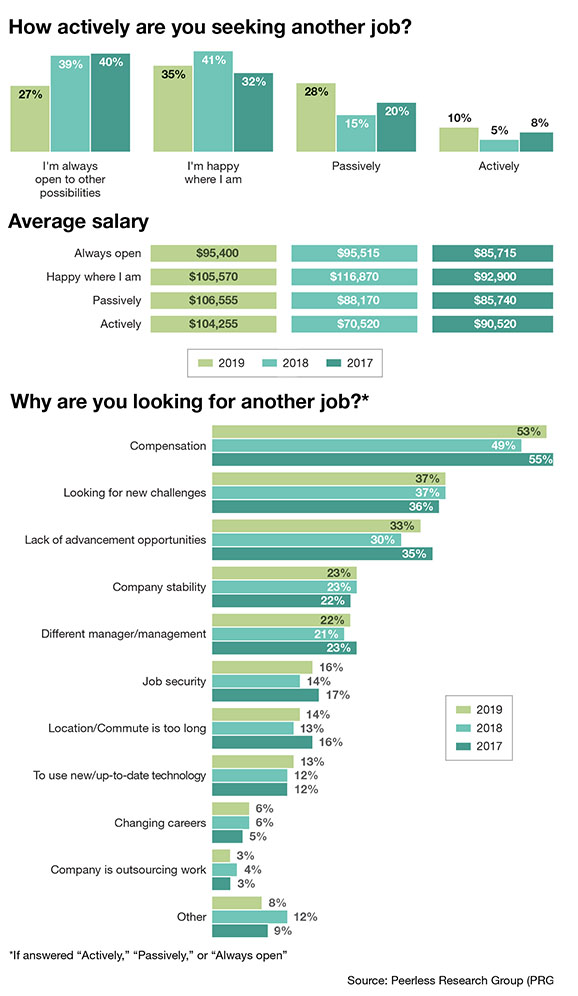 The average respondent earns $104,530. That is level with 2018, when averages salaries were up 13% following a flat year in 2017. The median salary also jumped from $87,000 to $92,000. Bonuses, on the other hand, fell sharply after five-consecutive years of growth. The average $20,820 earned from bonuses is 15% lower than last year. The median bonus is $12,000.
The average respondent earns $104,530. That is level with 2018, when averages salaries were up 13% following a flat year in 2017. The median salary also jumped from $87,000 to $92,000. Bonuses, on the other hand, fell sharply after five-consecutive years of growth. The average $20,820 earned from bonuses is 15% lower than last year. The median bonus is $12,000.
The average respondent is 52 years old and has worked with his or her current company for the past 10 years of a 19-year materials handling career. During that time, the average respondent has worked for 2.4 companies.
Females hold 11% of materials handling positions, and their average salary of $80,940 is a 7% improvement following a 6% increase in 2018 that finally broke a downward trend after a peak of $90,000 in 2015. The median female salary jumped from $71,000 to $77,000. The average male salary remained level at $105,525, while the median grew 5% to $95,500.
Of the 65% of respondents with budgetary responsibilities, the average oversees a budget of $208,700. This is based on the approximate spend level before respondents require management approval. About 14% have approval authority for at least $1 million, 72% manage less than $100,000, and 39% have authority over $10,000 or less. Average revenues tell a similar story, up 12% to $721 million (median: $169 million). The average company employs 2,508 people.
Among respondents, 75% have been in the materials handling industry at least 10 years, and 24% have been at it for more than 30 years. About 11% have been in the industry less than five years.
